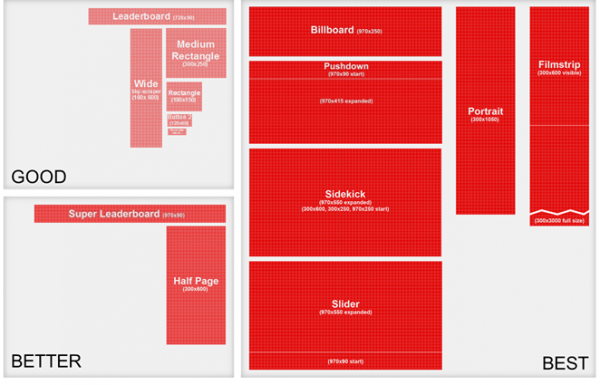IAB Releases Bigger, More Immersive Display Ad Unit Standards
The days of the good old medium rectangle, wide skyscraper and leaderboard may be numbered. The Interactive Advertising Bureau (IAB) has released a new standard display ad package that includes the 970×250 Billboard, the 970×90 Pushdown and the 300×600 Filmstrip, among others. It’s the first time the IAB has introduced a new standard ad portfolio […]
The days of the good old medium rectangle, wide skyscraper and leaderboard may be numbered. The Interactive Advertising Bureau (IAB) has released a new standard display ad package that includes the 970×250 Billboard, the 970×90 Pushdown and the 300×600 Filmstrip, among others. It’s the first time the IAB has introduced a new standard ad portfolio since 2003.
Notably, the new units, dubbed “Rising Stars,” are meant to be rich media units that take up a good percentage of screen real estate, and many obscure or push aside editorial content, at least temporarily, before settling into place.
“The new IAB portfolio allows creatives to tell bigger, bolder brand stories,” Randall Rothenberg, president and CEO of the IAB, said in a statement. “The new units offer more space, greater functionality, and a broader range of user experiences — providing a collection of next-generation interactive canvases designed to leverage the rich, immersive benefits of digital.”
The IAB is a bit late to the game with these larger units, as big brand publishers represented by the Online Publishers Association (OPA) have been utilizing and pushing for larger units since at least 2009.
Before introducing the new units, the IAB conducted research with IPG Media Lab, agencies including BBDO, Razorfish and SapientNitro, and clients like AT&T, Jeep, and Westin Hotels & Resorts. The findings showed that consumers were 2.5% more likely to interact with a Rising Stars unit than with the existing standard ad unit (leaderboard, medium rectangle, wide sky). They also spent twice as much time interacting with the ad and took less time to react to the ad. Eye tracking studies showed users viewed Rising Star ads longer — 31% more — than standard ad formats. People who viewed the ads also reported them to be more “enjoyable” and “engaging” and were more likely to say the ads “improved my impression of this web site,” as well as their opinion about the brand.
Here are all the details, including creative specs, recommended uses and more, at the IAB website.
Related stories
